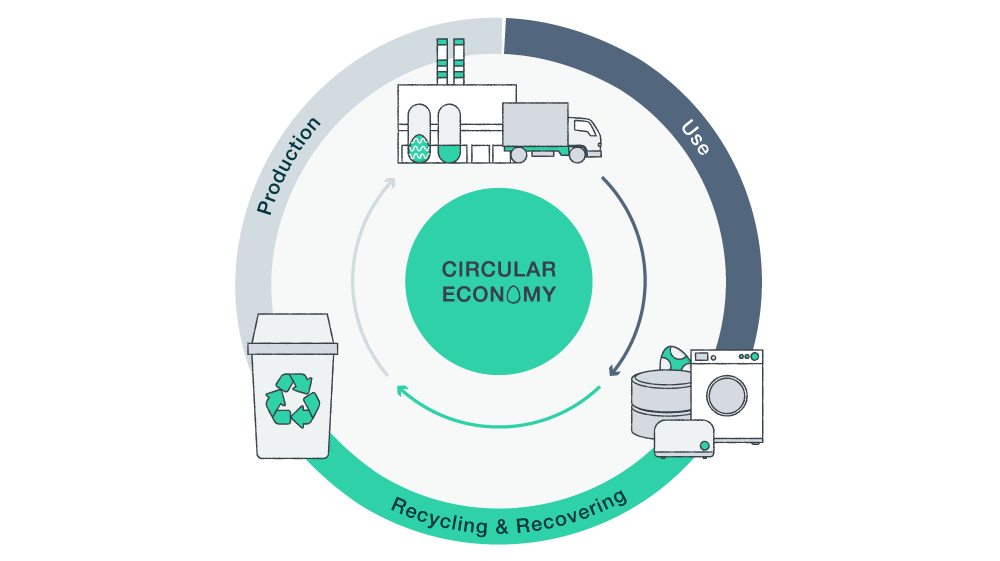A hitchhike to space – how Enerbrain sees circular economy in the energy market
By Attilio Di Sabato
What are a cowboy and an astronaut have got to do with circular economy?
We are increasingly aware of the impact that production processes have on our planet and of the paradigm shift needed to make the economic development of countries virtuous by reducing their environmental impact and use of resources.
For this reason, we have decided to illustrate the differences between the linear and circular economy models with a representation that we find simple but illuminating. Read it to believe it!
Traditional economy vs. circular economy

he traditional economic model is negatively characterised by the fact that it does not take into account the effects of production processes on the environment, relying on a linear scheme where resources are used:
- Extracted from the environment;
- Used for the production of goods and services;
- Then consumed by end customers
- Returned to the environment in the form of waste or to the atmosphere in the form of climate-changing emissions.
And that’s where the cowboy and the astronaut come in…
In 1966, Kenneth E. Boulding, a British economist and one of the first proponents of the circular economy, defined in his article “The Economics of the Coming Spaceship Earth” the linear economy as that of “the Cowboy” as opposed to that of “the Astronaut” described by him in the same article.
As described by Boulding, the cowboy is the symbol of the endless plains, of the tireless, romantic, violent and robbery behaviour that is characteristic of open societies. Whereas “The closed economy of the future must resemble the economy of the astronaut”.
Why an astronaut?
The answer is simple and comes from the knowledge that we live on a planet with limited resources: whatever we discard on the Planet stays on the Planet, which is our spaceship!
The problem is therefore the disposal of waste produced by human activities.
According to circular economy experts, the proposed solution is instead inspired by the biological processes of Nature where each element is continuously reused and recycled.
Hence the circular model that reduces waste by reusing it in other production processes, thus considerably reducing the overall amount of waste and consequently the need to extract new resources.
What is circular economy

The circular economy is essentially based on two major cycles: the biological and the technological. To the former belong those elements that can be reintegrated into the atmosphere while the latter refer to technical products that cannot be reintegrated into the biosphere, but can be revalorised through recycling and other circular actions.
The 5 business models of the circular economy
The benefits of a circular economy are not only environmental, but also economic.
Since 2010, the Ellen MacArthur Foundation, one of the most important bodies in this field, has outlined the business opportunities of the circular economy in its numerous reports. At present, many companies operating in the green economy consider the following 5 business models; let’s briefly see how these models have been applied to the energy sector:
Sustainable inputs
The use of renewable sources such as photovoltaics and wind power almost completely eliminates the use of natural resources for energy production, except for those used to produce the technical components of the renewable technologies in question.
Resource recovery and recycling
The use of discarded products or by-products is also crucial for energy circularity, an example being the use of food waste, the so-called ‘FORSU’ – organic fraction of municipal solid waste – to produce biofuels.
Product life extension
The growing focus on sustainability has prompted many companies to activate green procurement policies and thus to define minimum environmental criteria for their suppliers, emphasising in these documents the importance of purchasing technical components that last over time thanks to careful maintenance, for example.
Sharing platform
More and more utilities are launching sharing platforms for sustainable electric mobility, thus reducing traffic in cities, and supporting the electrification of means of transport. Another type of sharing concerns the reserve capacity of utilities, i.e. making available the reduction of their own energy consumption in Demand Response programmes.
Product as a service
This model contributes significantly to the paradigm shift in economic activities: companies no longer offer end products, they retain ownership of their products and instead sell their related services. In this way, companies can better structure their product reuse and recovery cycles, accelerating actions to reduce their ecological footprint.
From ‘Product as a Service’ to ‘Energy as a Service
The latest model presented is gaining momentum due to the ongoing energy transition that aims to make distributed generation central to the energy scheme.
In doing so, Energy as a Service (EaaS), a concept extended from “Product as a Service”, shifts the focus of companies from the mere supply of energy to the development of a suite of services useful to Prosumers, and their aggregations, for the management of self-produced and stored energy and the rescheduling of their consumption.
